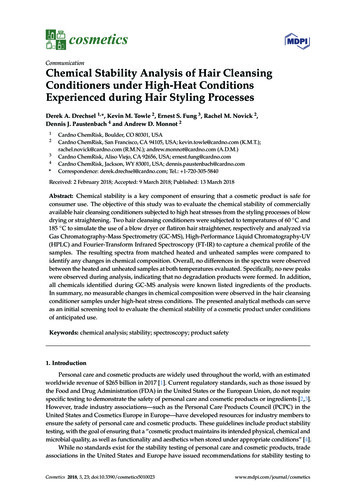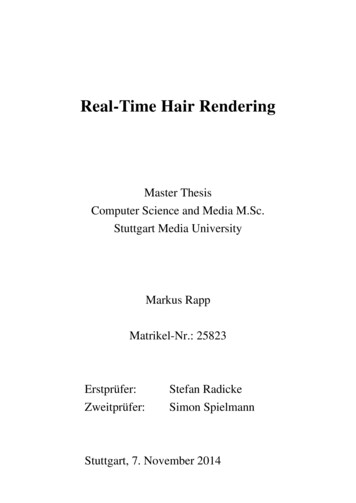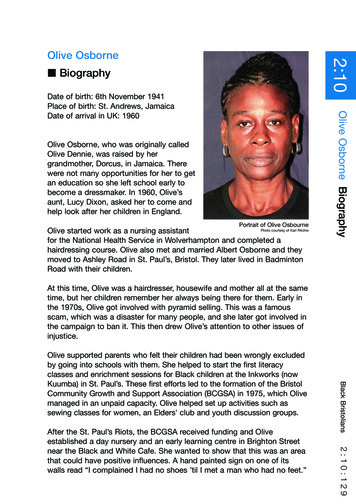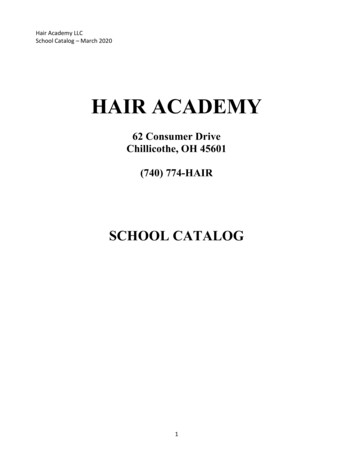
Transcription
cosmeticsCommunicationChemical Stability Analysis of Hair CleansingConditioners under High-Heat ConditionsExperienced during Hair Styling ProcessesDerek A. Drechsel 1, *, Kevin M. Towle 2 , Ernest S. Fung 3 , Rachel M. Novick 2 ,Dennis J. Paustenbach 4 and Andrew D. Monnot 21234*Cardno ChemRisk, Boulder, CO 80301, USACardno ChemRisk, San Francisco, CA 94105, USA; kevin.towle@cardno.com (K.M.T.);rachel.novick@cardno.com (R.M.N.); andrew.monnot@cardno.com (A.D.M.)Cardno ChemRisk, Aliso Viejo, CA 92656, USA; ernest.fung@cardno.comCardno ChemRisk, Jackson, WY 83001, USA; dennis.paustenbach@cardno.comCorrespondence: derek.drechsel@cardno.com; Tel.: 1-720-305-5840Received: 2 February 2018; Accepted: 9 March 2018; Published: 13 March 2018Abstract: Chemical stability is a key component of ensuring that a cosmetic product is safe forconsumer use. The objective of this study was to evaluate the chemical stability of commerciallyavailable hair cleansing conditioners subjected to high heat stresses from the styling processes of blowdrying or straightening. Two hair cleansing conditioners were subjected to temperatures of 60 C and185 C to simulate the use of a blow dryer or flatiron hair straightener, respectively and analyzed viaGas Chromatography-Mass Spectrometry (GC-MS), High-Performance Liquid Chromatography-UV(HPLC) and Fourier-Transform Infrared Spectroscopy (FT-IR) to capture a chemical profile of thesamples. The resulting spectra from matched heated and unheated samples were compared toidentify any changes in chemical composition. Overall, no differences in the spectra were observedbetween the heated and unheated samples at both temperatures evaluated. Specifically, no new peakswere observed during analysis, indicating that no degradation products were formed. In addition,all chemicals identified during GC-MS analysis were known listed ingredients of the products.In summary, no measurable changes in chemical composition were observed in the hair cleansingconditioner samples under high-heat stress conditions. The presented analytical methods can serveas an initial screening tool to evaluate the chemical stability of a cosmetic product under conditionsof anticipated use.Keywords: chemical analysis; stability; spectroscopy; product safety1. IntroductionPersonal care and cosmetic products are widely used throughout the world, with an estimatedworldwide revenue of 265 billion in 2017 [1]. Current regulatory standards, such as those issued bythe Food and Drug Administration (FDA) in the United States or the European Union, do not requirespecific testing to demonstrate the safety of personal care and cosmetic products or ingredients [2,3].However, trade industry associations—such as the Personal Care Products Council (PCPC) in theUnited States and Cosmetics Europe in Europe—have developed resources for industry members toensure the safety of personal care and cosmetic products. These guidelines include product stabilitytesting, with the goal of ensuring that a “cosmetic product maintains its intended physical, chemical andmicrobial quality, as well as functionality and aesthetics when stored under appropriate conditions” [4].While no standards exist for the stability testing of personal care and cosmetic products, tradeassociations in the United States and Europe have issued recommendations for stability testing toCosmetics 2018, 5, 23; osmetics
Cosmetics 2018, 5, 232 of 8industry members [4–6]. These voluntary guidelines are intended to be general recommendations toaid manufacturers in the development of storage and shelf-life instructions for a given personal careor cosmetic product. Specific testing procedures have not been established but each manufacturer isexpected to design a stability testing program that is suitable and scientifically sound for the marketedproduct [5]. Typical stability testing is designed to address three primary areas: (1) physical andchemical stability, including organoleptic properties (color, odor), pH, viscosity, texture and emulsion;(2) potential for microbial contamination; and (3) the impact of packaging on the contained product.Specifically, a number of testing approaches have been developed to evaluate physical and chemicalstability under predicted conditions of transport, storage and use. These include elevated temperatures,freeze-thaw cycles, light exposure and mechanical vibration. For example, thermal stability testing maybe conducted under accelerated or long-term test periods ranging from one to 12 months, with productstypically subjected to temperatures ranging from 25 C to 45 C [6].Stability testing is intended to provide data to establish “an expected use life and label storageinstruction” for the product under specific manufacturing and packaging conditions [4]. It should benoted that personal care and cosmetic products may be exposed to stress conditions beyond thoseanticipated during the transport and storage of a product. For example, physical and chemical stabilitytesting is typically conducted under elevated temperatures up to 45 C for several months to simulatepotential storage conditions. However, hair care products (such as shampoos or conditioners remainingon the hair or skin) may be exposed to high-heat stress from the styling processes of blow drying orstraightening. Average temperatures experienced during these styling processes may reach 60 C or185 C, respectively [7–9].Since chemical reactions are accelerated at elevated temperatures, heating processes could alterthe composition of the product and subject consumers to exposure of unanticipated chemical(s).Given that standard guidelines for stability may not adequately address such conditions associatedwith consumer use, such as the heating of products, the purpose of this study was to evaluate thechemical stability of commercially available hair cleansing conditioner products subjected to extremetemperatures commonly experienced during the hair styling process.2. Methods2.1. Sample PreparationTwo samples of commercially available hair cleansing conditioners were provided directly toan analytical laboratory from the manufacturer and stored at ambient conditions until the time ofanalysis. All chemical testing was performed by Avomeen Analytical Services (www.avomeen.com;Ann Arbor, MI, USA). For each chemical analysis, approximately 1 g of product was placed into a 20 mLglass scintillation vial. Two vials were prepared for each sample, one remained at room temperature(unheated) while the other was heated to the indicated temperature (heated). Samples were heated inan incubation oven to the specified temperature for 15 min [10]. To simulate the use of a blow dryer,one sample (sample A) was heated to 60 C. Meanwhile, the second sample (sample B) was heated to185 C to simulate average temperatures experienced during use of a flatiron straightener.Samples were removed from the oven, allowed to cool to room temperature and then analyzedto compare chemical profiles between heated and unheated samples. For High-Performance LiquidChromatography (HPLC) and Gas Chromatography-Mass Spectrometry (GC-MS) analysis, sampleswere dissolved in 10 mL of methanol and vortexed until mixed and dissolved. Samples were filteredusing a 0.45 µm PTFE filter and analyzed under the conditions described below.2.2. HPLC-UV AnalysisHPLC-UV analysis was performed using an Agilent 1100 system with a diode-array detector(DAD) using wavelengths of 210 nm, 230 nm, 254 nm and 280 nm. 10 µL of sample was injectedand separated using 5 µm Kinetex Luna C18 4.6 mm 150 mm column at 30 C. The mobile phase
Cosmetics 2018, 5, x FOR PEER REVIEWCosmetics 2018, 5, 233 of 83 of 8separated using 5 μm Kinetex Luna C18 4.6 mm 150 mm column at 30 C. The mobile phaseconsisted of 85% deionized water and 15% acetonitrile for 20 min, followed by 5% deionized waterconsistedof 85% deionizedwaterand15% 85%acetonitrilefor water20 min,followedby 5% deionizedwaterand 95% acetonitrilefor 10 minandfinallydeionizedand15% acetonitrilefor 15 minat aterand15%acetonitrilefor15minatconstant flow rate of 1.0 mL/min. All injections were run in triplicate.a constant flow rate of 1.0 mL/min. All injections were run in triplicate.2.3. GC-MS Analysis2.3. GC-MS AnalysisGC-MS analysis was performed using an Agilent 6890 N with the MSD 5973 system. ForGC-MSanalysiswas performedusingan aAgilent6890N withMSD5973system.matchedmatched samplessubjectto heating at60 C,0.25 μmHP-530 m the 0.32mmcolumnwasForused,while samplessubjectat 60C, a 0.25HP-530 m 0.32mm columnused, while1 µma 1 μm DB-530 tom heating 0.25 mmcolumnwasµmusedfor matchedsamplessubject wasto heatingat 185a C.All C. All otherDB-5m 0.25 mmcolumnwaswereused thefor samematchedsamplestoTheheatingat 185other30parametersdescribedbelowfor alltested w werethe samefor allsamples.The samplewaswas 1 μL atdescribed250 C. Columnflow wasconstantat testeda rate ofof 1.0 mL/min.The injectionGC oven volumetemperature C. Column flow was constant at a rate of of 1.0 mL/min. The GC oven temperature was1wasµL at250programmed at 50 C and increased to 300 C at a linear rate of 15 C/min. Temperatures of the at a linear rate of 15 C/min. Temperatures of theprogrammed50 C andincreasedto 300transfer line, atquadrupleandion sourcewereC280 C, 150 C and 230 C, respectively. MS analysis C, 150 C and 230 C, respectively. MS onditions were set to detect a mass range of 200–800 Da. All injections were run in triplicate.conditions were set to detect a mass range of 200–800 Da. All injections were run in triplicate.2.4. FT-IR Analysis2.4. FT-IR AnalysisFor Fourier-Transform Infrared Spectroscopy (FT-IR) analysis, after heating and cooling to roomFor Fourier-Transform Infrared Spectroscopy (FT-IR) analysis, after heating and cooling to roomtemperature, samples were placed in a 40 Cfreezer for two hours and were subsequently dried fortemperature, samples were placed in a 40 C freezer for two hours and were subsequently driedtwo days at 80 C using a lyophilizer. Dried samples were analyzed directly using a Perkin Elmerfor two days at 80 C using a lyophilizer. Dried samples were analyzed directlyusing a PerkinSpectrum 65 FT-IR. Scans were performed over the spectral range of 4000 cm 1 to 1600 cm 1, ataElmer Spectrum 65 1FT-IR. Scans were performed over the spectral range of 4000 cm to 600 cm 1 ,resolution of 4 cm .at a resolution of 4 cm 1 .3. ResultsResults3.3.1. HPLC-UVHPLC-UV3.1.Several compoundscompounds werewere detecteddetected inin thethe HPLCHPLCchromatogramschromatograms ofof thethematchedmatchedunheatedunheated andandSeveral heatedsamplessamples C at all examined.wavelengthsexamined. chromatogramsRepresentativeheatedfor forbothboth60 C 60and C185 andC at 185all wavelengthsRepresentativechromatogramsfor matchedheatedsamplesand unheatedsamplesexamined254 nm arepresentedinformatched heatedand unheatedexaminedat 254nm are atpresentedin ontimeandpeakareaforeachsamplewerefoundThe number of compounds, retention time and peak area for each sample were found to be reproducibleto be reproduciblebased ontriplicateanalysis.No differenceswere observedin thematchedheatedbasedon triplicate analysis.Nodifferenceswere observedin the matchedheated dryerandhairstraighterscenarios.Specifically,allof thefor both the blow dryer and hair straighter scenarios. Specifically, all of the peaks in the nheatedandheatedsampleshadthesameretentionfor the matched unheated and heated samples had the same retention times and any difference in peaktimes andanyunderdifferencein peakheightor area undercurve forthe compoundsinsamplesthe matchedheightor areathe curvefor thecompoundsin thethematchedunheatedand ss than 12%.FigureHigh-PerformanceLiquid Chromatography-UV(HPLC-UV) chromatogramsFigure1. Representative1. RepresentativeHigh-PerformanceLiquid Chromatography-UV(HPLC-UV) C (B) thheatingto60 C(A) orto185chromatograms of matched unheated (black) and heated (grey) samples withheating60 C(A) or254185nm. C (B) at 254 nm.
Cosmetics 2018, 5, 234 of 8Cosmetics 2018, 5, x FOR PEER REVIEW4 of 83.2. GC-MS3.2. GC-MSNine compounds were identified in sample A in the matched unheated and 60 C heated analysesNine compounds were identified in sample A in the matched unheated and 60 C heated(Figure 2A). Several peaks in the chromatograms were also found in the blank injection samples andanalyses (Figure 2A). Several peaks in the chromatograms were also found in the blank injectionwere therefore not labeled and disregarded from the analysis. The number of compounds, retentionsamples and were therefore not labeled and disregarded from the analysis. The number oftime and peak height for each sample were found to be reproducible based on triplicate analysis.compounds, retention time and peak height for each sample were found to be reproducible based onNo differences were observed in the number of compounds, retention times or peak height betweentriplicate analysis. No differences were observed in the number of compounds, retention times orthe unheatedand heatedsamples.ChemicalcompoundsforChemicalthe ninecompoundspeaks wereforidentifiedthroughpeak heightbetweenthe unheatedand heatedsamples.the nine peakswerea knownspectralibrary(Table1).identified through a known spectra library (Table 1).Figure 2.Representativetotal ionchromatogramsof matchedunheated(black)andandheated(grey)Figure2. Representativetotalion chromatogramsof matchedunheated(black)heated(grey) C185with heating60 C CNumbered(B). Numberedpeaksthoseidentifiedby comparisonsamplessampleswith heatingto 60 Cto(A)or (A)185or(B).peakswerewerethoseidentifiedby comparisonto a known(seefor details).Unlabeledpeaksin chromatogramsthe chromatogramswereto a knownspectraspectralibrarylibrary(see textfortextdetails).Unlabeledpeaksin tsubjecttoidentification.found in blank injections and were thus not subject to identification.1. Compoundsidentifiedhair ble 1.TableCompoundsidentifiedin matographyMassSpectrometry(GC-MS)analysis.Mass Spectrometry (GC-MS) analysis.Peak Number from Total IonPeak Number fromTotal Ion ChromatogramChromatogram1 12 234567893456789Sample A (60 C)Sample A (60 C)Sample B (185 C)Sample B (185 C)-LimoneneDD-LimoneneD-LimoneneD ol)(Menthanol)(Menthanol)cyclohexanol (Menthanol)Diethyl phthalateDiethyl canol(Cetylalcohol)1-Hexadecanol(Cetyl (Stearylalcohol)Dimantine(Stearyl mantine1-Octadecanol(Stearyl alcohol)DimantineStearyltrimethylammonium chloride-DimantineStearyltrimethylammonium chloride-Seven compounds were identified in sample B in the matched unheated and 185 C heatedSeven2B).compoundswereofidentifiedin sampleB in timethe matchedandeach185 Cheatedanalyses (FigureThe numbercompounds,retentionand peakunheatedheights forsampleanalyses (Figure 2B). The number of compounds, retention time and peak heights for each samplewere found to be reproducible based on triplicate analysis. No differences were observed in terms ofwere found to be reproducible based on triplicate analysis. No differences were observed in terms ofpeak number, retention time or peak area between the unheated and heated samples. The identifiedpeak number, retention time or peak area between the unheated and heated samples. The identifiedchemical compounds are presented in Table 1. All of the chemicals identified in the GC-MS analyses forchemical compounds are presented in Table 1. All of the chemicals identified in the GC-MS analysesboth products were listed as ingredients or components of ingredients in the respective commerciallyfor both products were listed as ingredients or components of ingredients in the respectiveavailablecleansing conditioners.commercially available cleansing conditioners.
Cosmetics 2018, 5, 23Cosmetics 2018, 5, x FOR PEER REVIEW5 of 85 of 83.3. FT-IR3.3. FT-IRThe FT-IR spectra of the matched unheated and heated samples are shown in Figure 3.The FT-IR spectra of the matched unheated and heated samples are shown in Figure 3. NoNo significant changes were observed between the matched unheated and heated samples uponsignificantchanges were observed between the matched unheated and heated samples upon heatingheating toto6060 C CC. Thereno additionalpeaksinorshifts in norabsorption,norevidencewas there anyoror185185 C. Therewere wereno additionalpeaks or shiftsabsorption,was there anyevidenceofoflossof absorptionheating.lossof absorptionupon uponheating.3. y(FT-IR)spectraof matchedFigure ctroscopy(FT-IR)spectraof matchedunheatedunheated (black) and heated (grey) samples with heatingto 60 C (A) or 185 C (B). (black) and heated (grey) samples with heating to 60 C (A) or 185 C (B).4. Discussion4. DiscussionThis study demonstrates the use of analytical methods to examine the chemical stability of apersonalproduct undersimulateduse. Specifically,we subjectedsamples fromaThisstudycaredemonstratestheuse of conditionsanalyticalof methodsto examinethe ngthea personal care product under simulated conditions of use. Specifically, we subjected samples fromhair styling processes of blow drying or hair straightening. No changes in the chemical compositiona commercial hair cleansing conditioner product line to temperature stresses experienced during theof matched unheated and heated samples were observed via HPLC, GC-MS and FT-IR analyses.hair stylingprocessesof blowdryinghair straightening.No changesthe C,chemicalcompositionSpecifically,no otherproductswereorobservedafter heating samplesto 60 C inor 185indicatingthatof matchedunheatedand heatedsampleswere observedvia temperatureHPLC, GC-MSanalyses.no detectabledegradationproductswere formedfollowing highstress.andThis FT-IRapproachrepresentsa formof stabilitytestingthat canbe adaptedevaluatetospecificmay beSpecifically,no otherproductswereobservedafterheatingtosamples60 Cstressorsor 185 thatC, aparticularpersonalcareorcosmeticproduct.no detectable degradation products were formed following high temperature stress. This approachanalysis provides an example of examining the chemical stability of a hair cleansingrepresents aThisformof stability testing that can be adapted to evaluate specific stressors that may beconditioner subjected to temperatures outside the bounds of standard stability testing guidelines dueencounteredduringthe anticipated use of a particular personal care or cosmetic product.to the increased temperatures experienced during hair styling processes. These extreme temperatureThisanalysisexample thatof examiningthe chemicalstability of basisa haircleansingvariationsareprovidesexamples anof conditionscan be incorporatedon a product-specificwhenconditionersubjectedto temperaturesoutside the bounds of standard stability testing guidelines duedevelopinga stabilitytesting program.Ensuringthe stabilityof ingredientsused hairin personaland cosmeticproducts temperatureunderto the increasedtemperaturesexperiencedduringstyling careprocesses.These ssurethatconsumersarenotexposedto whenvariations are examples of conditions that can be incorporated on a product-specific basisunforeseen chemicals, which could result in adverse health effects. Ingredients such as fragrancedeveloping a stability testing program.chemicals, preservatives and “natural” products, including botanicals and essential oils, have nd e potentialfor pecifically,severalof high heatstressfoundmay inbe fragrancesnecessaryandto assurethatareconsumersnot calssubject to areoxidationthat mayallergenicwhich couldresultinresultingadversedegradationhealth effects.Ingredientssuchas o theproduct.Examples ofthis includethe edcosmeticingredients,suchasgeraniol,linalool,and “natural” products, including botanicals and essential oils, have been identified as allergens withlimoneneand constituentsof lavender oil[11–13].[14–18]. Specifically, several chemicals found in fragrancesthe potentialfor inducingskin sensitizationTemperature is known to be an important determinant in the stability of chemicals and oxidativeand botanicals are subject to oxidation that may impart allergenic potential to the resulting degradationdegradation may be enhanced with increasing temperature. Specifically, the Arrhenuis equationproduct.demonstratesExamples ofthatthischemicalinclude reactionthe auto-oxidationproductsresultingtemperaturefrom degradationcommonlyrate increaseswith increasing[3,19,20]. ofWhileused neandconstituentsoflavenderoil[14–18].others have examined factors of product stability among personal care and cosmetic ture is known to be an important determinant in the stability of chemicals and oxidativedegradation may be enhanced with increasing temperature. Specifically, the Arrhenuis equationdemonstrates that chemical reaction rate increases with increasing temperature [3,19,20]. While othershave examined factors of product stability among personal care and cosmetic products (includingstorage temperature, ethanol, pH and UV light), this is the first known study to evaluate whetherthe stability of hair care products is impacted by temperature variations experienced during the hairstyling process [21–23].
Cosmetics 2018, 5, 236 of 8Analytical methods, including HPLC and mass spectrometry, have been used with increasingfrequency in the field of cosmetics to assess the chemical nature of product formulation and potentialdegradation products [24,25]. These approaches can be used to achieve a high degree of specificity andsensitivity lacking in less sophisticated methods. The methods applied in this analysis were intended toprovide a screening-level assessment of potential chemical changes resulting from exposure to extremetemperature variations. While the methods utilized in this analysis were intended to detect a varietyof chemicals present in hair cleansing conditioners (volatile vs. non-volatile, organic vs. non-organic),it was not designed to identify all potential compounds and their concentrations. Based on a product’sformulation and any particular concerns about any individual ingredient or chemical, more specificprocedures and analyses beyond the screening-level approach discussed here can be developedas part of a stability testing program. For example, several authors have developed the means todetect chemicals capable of inducing skin sensitization resulting from the oxidation of fragrancematerials [26,27].While this analysis was intended to simulate the impact of high temperature stress of hair-careproducts, it is important to recognize that it is not completely representative of conditions experiencedby the consumer. Consumer product usage surveys have reported that the mean amount of shampooand conditioner product applied per application is 11 g and 13 g, respectively [28,29]. However,only one percent of the product is expected to remain on the hair and skin following washing andrinsing [30]. Therefore, it is likely that any product remaining on the hair and skin would form a thinfilm, with an increased surface area to volume ratio than the form of the product examined in thecurrent study. Under these conditions, heating may lead to changes in temperature distribution,increased loss of volatile chemicals through vaporization, or increased oxidation reactions. Futureanalyses may seek to address such issues.5. ConclusionsOverall, this analysis provides evidence that subjecting a commercial hair cleansing conditionerto temperatures which may be experienced during the hairstyling process does not result in detectabledegradation of the product. These results suggest that consumers would not be exposed to anyunforeseen chemical constituents that could be formed as a result of product degradation fromhigh-heat stress. The presented analytical methods can serve as an initial screening tool to evaluatechemical stability of a personal care or cosmetic product under conditions of anticipated use.Author Contributions: All authors (Derek A. Drechsel, Kevin M. Towle, Ernest S. Fung, Rachel M. Novick,Dennis J. Paustenbach, and Andrew D. Monnot) conceived and designed the experiments; Avomeen AnalyticalServices performed the experiments; Derek A. Drechsel, Kevin M. Towle, and Andrew D. Monnot analyzed thedata; Derek A. Drechsel, Kevin M. Towle, and Andrew D. Monnot wrote the paper.Conflicts of Interest: Authors Derek A. Drechsel, Kevin M. Towle, Ernest S. Fung, Rachel M. Novick,Dennis J. Paustenbach and Andrew D. Monnot are employed by Cardno ChemRisk, a consulting firm thatprovides scientific advice to the government, corporations, law firms and various scientific/professionalorganizations. Cardno ChemRisk has been engaged by WEN by Chaz Dean, Inc. (WCD), which producespersonal care products, including the product examined in this study. This paper was prepared and writtenexclusively by the authors without review or comment by any outside entity. It is possible that this work will berelied upon in litigation. Funding for the research and preparation of this article was provided by WCD.References1.2.Yeomans, M. Global Beauty Market to Reach 265 Billion in 2017 Due to an Increase in GDP.Available online: due-to-an-increase-in-GDP (accessed on 22 January 2018).Food and Drug Administration (FDA). FDA Authority over Cosmetics: How Cosmetics AreNot FDA-Approved, but Are FDA-Regulated. Available online: awsRegulations/ucm074162.htm (accessed on 27 November 2017).
Cosmetics 2018, 5, 1.22.23.24.7 of 8Regulation EU No. 1223/2009 of the European Parliament and of the Council of 30 November 2009 onCosmetic Products (Recast) (Text with EEA Relevance). L 342/59. Available online: http://eur-lex.europa.eu/legal-content/EN/TXT/?uri CELEX:02009R1223-20160812&from EN (accessed on 6 March 2018).Personal Care Products Council (PCPC). Guidelines for Industry: The Stability Testing of Cosmetics; PersonalCare Products Council: Washington, DC, USA, 2011; p. 1.Cosmetic, Toiletry and Fragrance Association (CTFA); Colipa. Guidelines on Stability Testing of CosmeticProducts. 03/094—MC. March 2004; Cosmetics Europe, Personal Care Association: Brussels, Belgium, 2004.International Federation of Societies of Cosmetic Chemists (IFSCC). Monograph Number 2: The Fundamentalsof Stability Testing; Micelle Press: Weymouth, UK, 1992.Lee, Y.; Kim, Y.D.; Hyun, H.J.; Pi, L.Q.; Jin, X.; Lee, W.S. Hair shaft damage from heat and drying time of hairdryer. Ann. Dermatol. 2011, 23, 455–462. [CrossRef] [PubMed]Breuning, E.E.; Papini, R.P. Hair straighteners: A significant burn risk. Burns 2008, 34, 703–706. [CrossRef][PubMed]Dussaud, A.; Rana, B.; Lam, H.T. Progressive hair straightening using an automated flat iron: Function ofsilicones. J. Cosmet. Sci. 2013, 64, 119–131. [PubMed]Harding, E. How Much Time Do You Really Spend Doing Your Hair, Ladies? Answer: Ten Days a Year!Available online: days-year.html (accessed on 8 September 2016).Bickers, D.R.; Calow, P.; Greim, H.A.; Hanifin, J.M.; Rogers, A.E.; Saurat, J.H.; Sipes, I.G.; Smith, R.L.;Tagami, H. The safety assessment of fragrance materials. Regul. Toxicol. Pharmacol. 2003, 37, 218–273.[CrossRef]Scientific Committee on Consumer Safety (SCCS). Opinion on the Mixture of 5-Chloro-2-Methylisothiazolin3(2H)-One and 2-Methylisothiazolin-3(2H)-One. COLIPA n P56. SCCS/1238/09.Antignac, E.; Nohynek, G.J.; Re, T.; Clouzeau, J.; Toutain, H. Safety of botanical ingredients in personal careproducts/cosmetics. Food Chem. Toxicol. 2011, 49, 324–341. [CrossRef] [PubMed]Opdyke, D.L.J. Monographs on fragrance raw materials. Food Cosmet. Toxicol. 1975, 13, 683–923. [CrossRef]Skold, M.; Borje, A.; Matura, M.; Karlberg, A.T. Studies on the autoxidation and sensitizing capacity ofthe fragrance chemical linalool, identifying a linalool hydroperoxide. Contact Dermat. 2002, 46, 267–272.[CrossRef]Hagvall, L.; Backtorp, C.; Svensson, S.; Nyman, G.; Borje, A.; Karlberg, A.T. Fragrance compound geraniolforms contact allergens on air exposure. Identification and quantification of oxidation products and effect onskin sensitization. Chem. Res. Toxicol. 2007, 20, 807–814. [CrossRef] [PubMed
These guidelines include product stability testing, with the goal of ensuring that a "cosmetic product maintains its intended physical, chemical and microbial quality, as well as functionality and aesthetics when stored under appropriate conditions" [4]. While no standards exist for the stability testing of personal care and cosmetic .










